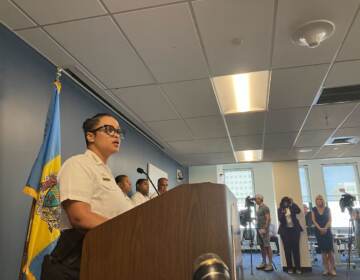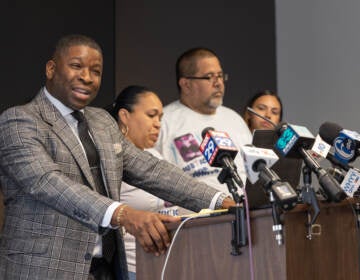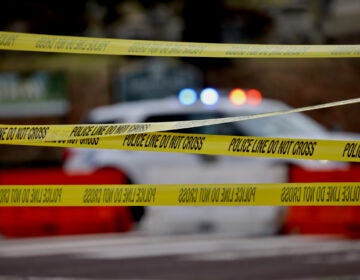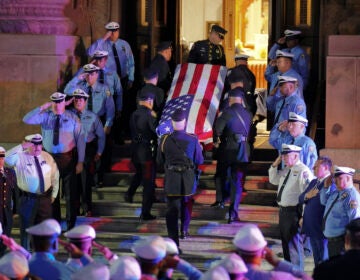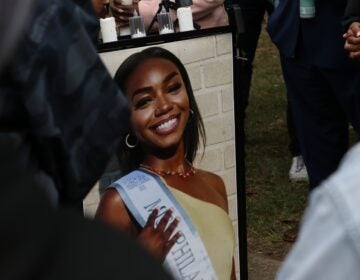Eddie Irizarry Jr. killing and PPD response reveal lack of transparency and accountability, experts say
In Philadelphia, where relationships between police officers and residents are already strained, the fatal shooting of Eddie Irizarry Jr. could have larger consequences.
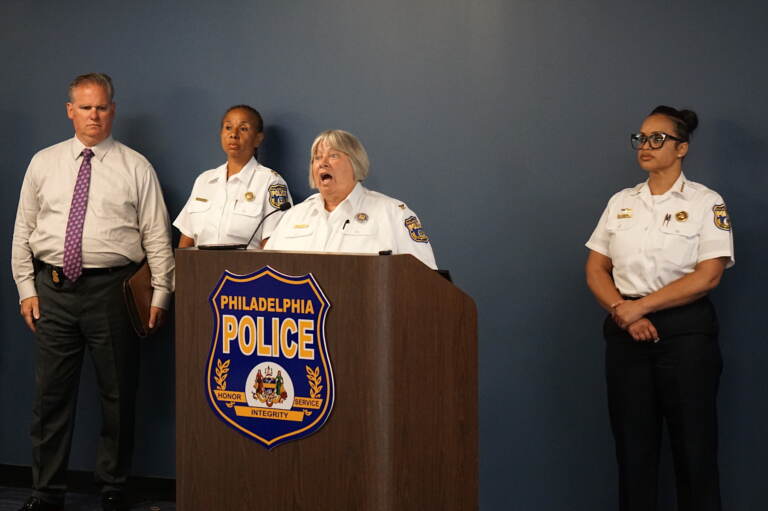
Christine Coulter, the PPD’s Chief of Detectives, explains new details surrounding the shooting death of Eddie Irizarry. Commissioner Danielle Outlaw and other law enforcement stand nearby. (Sam Searles/WHYY)
The police killing of Eddie Irizarry Jr. and the Philadelphia Police Department’s response to it reveal larger problems with training, culture, and accountability in law enforcement, according to criminal justice experts.
Philadelphia Police Commissioner Danielle Outlaw announced this week that the department has suspended Officer Mark Dial with intent to terminate him in 30 days. Dial fatally shot 27-year-old Irizarry Jr. on Aug. 14.
Irizarry Jr. was in the driver’s seat of his car when Dial fired six shots, first directly into the vehicle and then toward it according to home security footage of the incident.
Outlaw is moving to fire Dial because of his failure to cooperate with the internal investigation into that shooting, she said. Dial did not provide a statement about the shooting within the department’s required 72-hour window.
His use of lethal force is also being considered in a criminal investigation overseen by the Philadelphia District Attorney’s Office. Neither agency has shared updates or a timeline for that investigation.
The day the incident occurred, a PPD officer told the press that Irizarry Jr. had exited his vehicle with a knife and was lunging at Dial and another officer. Two days later, Outlaw said body-worn camera footage revealed that Irizarry Jr. never exited the car.
Thaddeus Johnson, a former Memphis Police Department officer who now teaches criminal justice at Georgia State University, said this is a major step back for the city.
“You can make a lot of mistakes, but the one thing you can’t do is lie,” said Johnson, who is also a senior fellow with the Council on Criminal Justice.
He says a false narrative making it from the shooting scene to the public has broader repercussions than Dial’s termination.
“It brings up these old feelings of George Floyd, it brings up these old feelings of Sandra Bland,” he said. “It does damage to not just the police department, but those citizens who really need police to help them who now are a little bit hesitant … How can you have homicides cleared if you don’t trust the police?”
ACLU of Pennsylvania is calling on the Philadelphia District Attorney’s Office to prosecute Dial and the other PPD employee present for the shooting.
“It’s very clear the police officers lied on the initial report to evade responsibility for their questionable handling of the situation,” said Witold Walczak, legal director for ACLU of Pennsylvania, in an emailed statement. “These kinds of lies to evade consequences will stop only if police and prosecutors pursue appropriate criminal charges each and every time a law enforcement officer is caught lying.”
Officer Dial is being represented by the Fraternal Order of Police Lodge 5. The union is referring press to their attorney, Fortunato Perri Jr., who has not responded to WHYY News’ requests for comment.
‘A culturally natural process’
Outlaw said that the misinformation about Irizarry Jr. lunging at the officers came from an “internal” source, and that the narrative was established before she and others arrived on the scene.
She shared at a press conference that an administrative investigation is underway to figure out where that account originated.
Nicole Gonzalez Van Cleve, an associate professor of sociology at Brown University, has studied police misconduct in Chicago, Philadelphia, and other cities. She says there are consistent patterns of officers covering up bad behavior, often spontaneously.
“They’re not in a dark room doing this — they’re out in the open and it seems a very culturally natural process,” she said. “Almost like an improvisational dance team … or someone doing jazz. They know the rhythms and the movements of the structures of these narratives.”
Gonzalez Van Cleve spent most of the 2010s working in Philadelphia. She says police officers are much more likely to shoot to kill — and to paint the person they’ve shot at as a suspect — when they’re patrolling in neighborhoods of color, and in places where crime is frequent.
“Think about the flagrant knee jerk reaction, what does it tell us about the culture of policing in Philadelphia?” she asked. “It means that you were trained in a particular way of doing business on the streets of Kensington, and you know you’ll be believed, and you know your brothers in blue will help you.”
Whether or not the truth about officer conduct comes to light depends on the relationship between police and prosecutors, Gonzalez Van Cleve said. In a 2020 Boston Law Review paper she lays out how co-dependent relationships between prosecutors and police often allow officers to evade consequences for crimes. She uses the police killings of Michael Brown, Philando Castille, Stephon Clark, and others as examples.
“[Prosecutors] need the police officers to win cases, they need them to be their star witnesses,” she said, adding that many officers feel they have a “free pass” because they know they won’t be charged.
But Gonzalez Van Cleve says Philadelphia is an outlier.
“It’s one of the only jurisdictions that has a reform-oriented prosecutor that was elected by the city to enact basic changes and accountability to how we understand patrolling crime,” she said. “In some ways that sets a stage and a political tone to make sure this case is handled in a way most Philadelphians will feel good about.”
Only six U.S. police officers have been convicted of murder since 2005, according to criminologist Phillip Stinson, the principal investigator at Bowling Green State University’s Police Integrity Research Group.
Stinson counts 184 officers who have been arrested for murder or manslaughter resulting from an on-duty shooting since then. But only 59 were convicted of a crime. Those crimes included manslaughter, misconduct, reckless endangerment, negligent homicide and reckless discharge of a firearm. Sentences ranged from zero to 480 months in prison, with an average of 65 months.
The 81 officers who were not convicted were acquitted, had their cases dismissed, or received deferred adjudication. Forty-four cases are still pending as of August 7.
“It’s very difficult for prosecutors to obtain a conviction in this type of case,” said Stinson of the Irizarry Jr. shooting. “The public expects charges will be brought right away, and in these cases sometimes the work of the prosecutors making charging decisions are hampered by a lack of cooperation from the police department and the fact that the statements from the officers appear to not be true. I would urge everyone to have patience.”
Philadelphians haven’t launched large-scale protests over Irizarry Jr.’s death, as they did when Philadelphia police officers shot and killed Walter Wallace Jr. in October 2020.
Delaware County activist Alim Howell with Race for Peace — an event designed to bridge the gap between police and citizens — is advocating for more stringent use of body-worn cameras for officers.
“All police departments, districts, precincts, stations, and headquarters should get a grip on stopping their behavior,” Howell wrote in an unpublished op-ed. “Because the retaliation of their behavior has been nothing but pure rage plus upset from citizens and the family members.”
The last time the Philadelphia District Attorney’s Office arrested and charged an officer with fatally shooting a civilian was in 2022, according to a spokesperson. Officer Edsaul Mendoza was charged with the murder of 12-year-old TJ Siderio.
“The DA’s Office intends to keep its sworn obligation to seek justice for all those involved in the fatal shooting of Mr. Irizarry, as well as for all those Philadelphians who are not directly involved but who care deeply about fairness, justice, and independence,” an emailed statement from the office reads.
Earlier this year Philadelphia Police Department officers shot and killed Curtis Smith in North Philadelphia and Dimitri Klimov in Kensington.
‘Microwave training’
Following the murder of George Floyd, the Philadelphia Police Department created a training model focused on de-escalation, crisis communication, and rapid decision-making, according to a write-up from the U.S. Department of Justice.
In November 2022 they launched a Behavioral Health Unit to help officers respond to people experiencing mental health crises. Irizarry Jr.’s family says he lived with schizophrenia.
Mayor Jim Kenney commended the police department for its training program Tuesday.
“We have made tremendous training programs in our police academy and ongoing training,” he said. “This situation obviously is tragic, and the investigation will bring out what the investigation will bring out and we’ll go from there.”
Johnson, the Georgia State University criminologist, said training can help officers make better decisions in the field, but only if it’s consistent and thoroughly implemented.
“We tend to do microwave training with police and then think it’s going to change overnight,” he said. “And beyond having policies in place you have proper supervision, and supervisors who are not having too many officers that it’d be really beyond the span of their control.”
PPD also uses the Active Bystander for Law Enforcement (ABLE) curriculum, created by the Georgetown Law Center for Innovations in Community Safety, to teach officers how to intervene when they see a colleague about to make a potentially dangerous mistake.
In August 2022, the Philadelphia Police Department began working on an Early Intervention System, which allows police departments to “proactively monitor their personnel to offer supportive interventions, which aim to prevent personnel from engaging in misconduct.”
It’s difficult to measure whether Early Intervention Systems are preventing police use-of-force incidents — but they show some promise, said Walter Katz, vice president of criminal justice for philanthropy Arnold Ventures.
“It’s not going to solve all problems,” he said. “Policing has to think across the entire spectrum, everything from hiring to training to supervision, when it wants to really think about how to provide constitutional police services for everyone in the community.”

Get daily updates from WHYY News!
WHYY is your source for fact-based, in-depth journalism and information. As a nonprofit organization, we rely on financial support from readers like you. Please give today.


